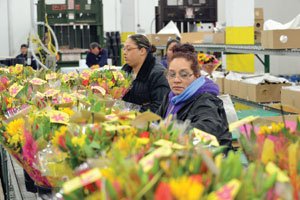Sophisticated Logistics Network Required to Ensure Flowers Arrive in Fine Form

Whether peonies and ranunculus for a wedding bouquet or a single red rose for a loved one, people across the United States keep finding reasons to purchase fresh-cut flowers, but few are aware of what’s involved to satisfy their demand.
Getting the colorful dainties to the floral shop requires a logistics network of trucking companies, airlines, floral importers, freight forwarders, wholesalers and retailers.
“There are very few that transport flowers because it’s a special commodity,” said David Armellini, president of Armellini Express Lines. “We have freight forwarders in Colombia that we own and a freight forwarder in Miami. So we have the facilities to [move] the product all of the way from Florida to the mass market.”
Armellini Express Lines, the largest transporter of fresh-cut flowers in the United States, with logistics headquarters in Palm City, Florida, specializes in less-than-truckload and on-demand truckload services by utilizing temperature-controlled equipment that operates from major ports.
“[There’s] a high demand for trucks at that peak at the end of April, beginning of May. And it stays strong till about two weeks [into] July because you have the June weddings and graduations and all of those type of things that happen for the months of May and June,” Armellini said.
Also during the peak holiday seasons, there is an increased desire for imported flowers, which mostly stem from Latin American countries.
The U.S. Foreign Agricultural Service, a division of the Department of Agriculture, reports that, of the 2.91 billion flowers imported into the United States last year, more than 2.29 billion came from Colombia, followed by 448.2 million from Ecuador. The value of flowers imported into the United States was about $670 million, according to the agency. Roses made up the bulk of imports at 1.58 billion.
The journey of a flower from the fields of Colombia to the shelves of U.S. floral shops is no simple feat, largely because it is a time-sensitive operation.
Jose Acosta, the UPS Americas Region president of Latin American operations and public affairs, said that the process of moving flowers starts with them being cut, hydrated and packed in coolers while still in the fields where they are grown.
Then the flowers are taken by a refrigerated truck to a temperature-controlled aircraft bound for Miami International Airport. Temperatures are kept between 34 and 38 degrees Fahrenheit to prevent freezing or premature blooming.
“They need to be cooled as they are transported all along the way, whether they are here in the United States or in the country of origin,” said Christine Boldt, executive vice president of the Association of Floral Importers of Florida. “As soon as it arrives [in Miami], it’s put in a cooler. And then from that point on, it is transported from the airport in a refrigerated truck.”
She said 91.4% of all floral imports come to Miami. Then they are inspected for bugs and diseases by the U.S. Customs and Boarder Protection. If they pass inspection, the flowers will go to an importer, to a warehouse or to a freight forwarder who will arrange for the flowers to be shipped to a wholesaler.
“Eighty-five percent of the time, [the wholesaler will] tell them to put it on a trucking company like ourselves, and we’ll transport them on an LTL basis to the florist,” Armellini said.
Corey Doel, manager of Prime Floral, said his company arranges for trucks to carry the flowers imported into the United States to wholesalers throughout the floral industry. The company is a division of Prime Inc., a Springfield, Missouri-based refrigerated, flatbed and liquid bulk truckload carrier that ranks No. 22 on the Transport Topics Top 100 list of the largest for-hire carriers in the United States and Canada.
From the wholesaler, the flowers are sold to retailers and eventually to consumers.
The fresh-cut delicacies aren’t all imports, however.
The USDA’s recent Floriculture report showed the wholesale value of domestically produced cut flowers was $354 million for 2014, based on operations with $100,000 or more of sales, down 3% from 2013. California produced the most, with a value is $274.6 million. Other large producers were Washington, New Jersey Oregon and Hawaii.
Prime Floral has drop-off locations in California, Doel said. “We provide daily shuttles of product going from those drop-off locations [in Watsonville and Vista] to our main hub in Oxnard, California,” he said.
From there, just like with imports, they’re routed to wholesalers to be sold to retailers.
“A lot of times, if it’s local, the retailers come over and pick it up. Sometimes there is a direct delivery to their door,” said Kevin Bergman, who works in administrative operations at Prime Floral. “So it all depends on what the retailer and the wholesaler have set up together.”

